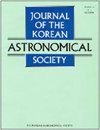G192.8-1.1:由附近大质量恒星重新点燃的演化热复合超新星遗迹的候选者
IF 0.8
4区 物理与天体物理
Q3 ASTRONOMY & ASTROPHYSICS
引用次数: 0
摘要
G192.8-1.1一直被认为是银河系中最微弱的超新星遗迹(SNRs)之一,直到Gao等人(2011)证明G192.8-1.1的射电连续体是热的。然而,G192.8-1.1的性质尚未得到充分研究。本文报道了在G192.8-1.1附近可能发现微弱的非热射电连续谱成分,其光谱指数为α ~ 0.56 (S ν∝ν -α),而大部分射电连续谱发射是热发射。此外,我们的阿雷西博HI数据揭示了一个HI壳,膨胀速度为20-60 km s -1,与射电连续辐射具有良好的形态相关性。估计HI壳层的物理参数以及非热射电连续辐射与其可能的关联表明,G192.8-1.1的信噪比为~ 0.3 myr。然而,热射电连续体的存在意味着在同一区域存在早期型恒星。一种可能性是,一颗大质量恒星正在电离一个老信噪比的内部。如果是这样的话,热辐射中心峰值表面亮度假设的电子分布意味着G192.8-1.1是“热复合”信噪比,而不是典型的壳型信噪比,即在x射线中曾经明亮的中心热气体已经冷却。因此,我们提出G192.8-1.1是一个古老的演化热复合信噪比,在射电连续体中显示出由附近的大质量恒星引起的反复发射。红外图像支持G192.8-1.1的HI壳层目前正在遇到附近的恒星形成区域,该区域可能包含一颗早期型恒星。本文章由计算机程序翻译,如有差异,请以英文原文为准。
G192.8-1.1: A CANDIDATE OF AN EVOLVED THERMAL COMPOSITE SUPERNOVA REMNANT REIGNITED BY NEARBY MASSIVE STARS
G192.8-1.1 has been known as one of the faintest supernova remnants (SNRs) in the Galaxy until the radio continuum of G192.8-1.1 is proved to be thermal by Gao et al. (2011). Yet, the nature of G192.8-1.1 has not been fully investigated. Here, we report the possible discovery of faint non-thermal radio continuum components with a spectral index α ~ 0.56 (S ν ∝ν -α ) around G192.8-1.1, while most of the radio continuum emission is thermal. Also, our Arecibo HI data reveal an HI shell, expanding with an expansion velocity of 20-60 km s -1 , that has an excellent morphological correlation with the radio continuum emission. The estimated physical parameters of the HI shell and the possible association of non-thermal radio continuum emission with it suggest G192.8-1.1 to be an ~ 0.3 Myr-old SNR. However, the presence of thermal radio continuum implies the presence of early-type stars in the same region. One possibility is that a massive star is ionizing the interior of an old SNR. If it is the case, the electron distribution assumed by the centrally-peaked surface brightness of thermal emission implies that G192.8-1.1 is a “thermal-composite” SNR, rather than a typical shell-type SNR, where the central hot gas that used to be bright in X-rays has cooled down. Therefore, we propose that G192.8-1.1 is an old evolved thermal-composite SNR showing recurring emission in the radio continuum due to a nearby massive star. The infrared image supports that the HI shell of G192.8-1.1 is currently encountering a nearby star forming region that possibly contains an early type star(s).
求助全文
通过发布文献求助,成功后即可免费获取论文全文。
去求助
来源期刊

Journal of the Korean Astronomical Society
地学天文-天文与天体物理
CiteScore
1.30
自引率
10.00%
发文量
0
审稿时长
>12 weeks
期刊介绍:
JKAS is an international scientific journal publishing papers in all fields of astronomy and astrophysics. All manuscripts are subject to the scrutiny of referees. Manuscripts submitted to JKAS must comply with the ethics policy of JKAS. Six regular issues are published each year on February 28, April 30, June 30, August 31, October 31, and December 31. One year''s issues compose one volume.
 求助内容:
求助内容: 应助结果提醒方式:
应助结果提醒方式:


